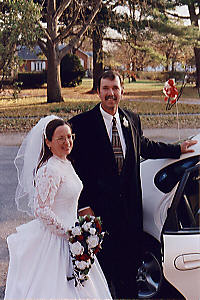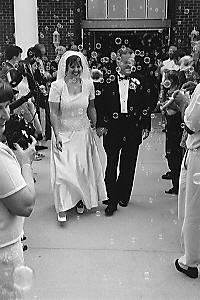 |
|
 |
|
After the Wedding and Reception
Don't rewind that last roll of film at the reception! Leave it in the camera until you drive away from the reception. Ensure you have accounted for and have all the rolls of film and all your equipment before you leave. After a mile or two, or when you get home, then you can rewind the last roll. Don't forget about it though. Reason? Invariably there is always just one more photograph to make on the way out the door. If nothing else, you might just see something about the "getaway car" being decorated on the way to your vehicle, and if you've already unloaded the camera, it's too late! This was one of my mistakes and I missed some rather cute things being done to their car as the reception was ending. Not a disaster, and not on the "Must Have" list, but they would have made some good candids. Ensure you have accounted for and have all the rolls of film before you leave.
Film Processing
Take the film in for processing at the professional lab you've chosen as soon as possible after the wedding. Hand carrying it to the lab is highly recommended. If you cannot do that within a reasonable time (during the week following the wedding) then mail or ship it, but do so only with some form of confirmation or tracking and verify that it really got there. Professional film need not be refrigerated after it's exposed, but it should not be subjected to extreme heat or humidity either. Storage at room temperature is perfectly OK. Letting it bake inside a car during the middle of Summer for even a day is not recommended.Ensure the lab knows exactly what you want (how many copies of proofs, etc.) and that you know when you can pick up the negatives and prints. Turnaround can be anything from several hours to a couple of days. Few pro labs perform "one-hour" service (unless you pay a premium for it). Picking up the developed film and all the prints you've had made should be done in person, if at all possible. Inventory everything to ensure you've gotten back all your negatives and all the proofs or prints you've requested. Then inspect the proofs (prints) to see if there are any flaws in their printing. Do this before you leave the lab. As with delivering the film, if you cannot pick it up in person then have it shipped with some form of tracking or confirmation that you can verify.
Archiving
Organizing and archiving the negatives and proofs is a little tedious, but shouldn't take that long. You should have archival sleeves for the negatives. Most convenient are pages of sleeves that have holes for a 3-ring binder. Label the sleeves with a unique roll number for each roll of film. If you must write on a sleeve itself (instead of a border) then do this before you put any negatives in it. You don't want to indent any negatives with your writing! Then label each proof on the back with the roll number and frame number for its matching negative. This makes finding the exact negative for a proof infinitely easier. I use a blue fine-point "Sharpie" indelible marker for this. Don't stack the proofs until you are certain the ink is dry. Labeling the proofs is important; shuffling through a pile of several hundred proofs and negatives to match them for printing later is a royal pain!Proof Book
After labeling them, proofs should be placed in a proof book to protect them. It need not be expensive; certainly under $10 although you can easily spend $50 or more for a fancy leather bound one with names and date imprinted in gold leaf. I view a proof book as temporary protective storage for the proofs until prints are mounted in a final album.Deliver the proof book to the bride and groom. I repeat: deliver it to the bride and groom! You may be barraged by requests from others to see them first. No, the answer is ALWAYS NO. The sole exception can be your spouse. Mine helped me archive the proofs which was a convenient compromise to let her see them. Reason? The proofs should be every photograph you made (good, bad and mediocre). Yes, you can pull something that is completely and hopelessly botched beyond any redemption. However, be very judicious about doing it (and don't throw them away). Even a poor one may be the sole photograph containing someone's favorite Great Aunt Ethel giving it great value in spite of whatever is wrong with it technically or aesthetically. The bride and groom should decide which ones the rest of the world sees; it was their wedding.
Reprints
If you arranged with the Bride and Groom (during your planning) to handle the reprints, have them make a list of which ones they want and the sizes for them. Provide a price list showing the cost of this with the proof book. If you agreed to pay for reprints, hopefully you put a cap on either the cost or the quantity (by size). Otherwise, you poor bankrupted soul! Even if they are paying all the cost of reprints, I suggest handling having it done by the same lab that did the developing and proofs. Yes, it's a little work, but it provides a consistency of printing (color balance, etc.) so the reprints will look like the proofs and lets you check to ensure the lab does good work. (You did run at least a test roll or two through them during you planning, right?) It's helpful if you provide a simple form that identifies the reprint by roll number, frame number and how many of each print size is desired (it also helps you figure out the cost). As with any business arrangement, have the Bride and Groom cover whatever costs you've agreed to when they give you their reprint order, not after you've had them done, and certainly not at some time after you've delivered the reprints to them. Yes, may seem a little tough, but handling it the same as a straight business transaction prevents hard feelings of a friend or relative owing you money for a long time (if this doesn't bother you, go ahead, but it may still gnaw at them even though they don't say anything).
Negatives
After you've delivered the proofs and handled getting any reprints for them that you've agreed to, deliver the archive of negatives to them. I did this in a simple folder that had clips to hold the pages of negative sleeves. Include a simple set of instructions advising proper storage of the archive in a cool dry place, protected from direct sunlight. Since they are already organized by roll and frame number, it will be easy for them to find a negative for any further reprints at a later date.
Now What?
When you've delivered all the negatives to the Bride and Groom, cogratulations, you're done and no longer in the wedding photography business! Celebrate, then buy a roll or two of your favorite film, plan a project around what you normally like to photograph, and go shoot it! After going through what you you have just done and surviving the ordeal, it's time to take the "Wedding Photographer" shingle down and get back to the photography you enjoy most. If you found you liked it, want to put your equipment through continuous hard use, then put the shingle back up, put together a business plan so you can make (and not lose) money at it. Then use the proceeds to feed your photography habit. Just be ready to start buying some lighting equipment you most likely did not have for this one, and perhaps some lenses too.Hoping Your Wedding Shoot is Successful . . .
-- John